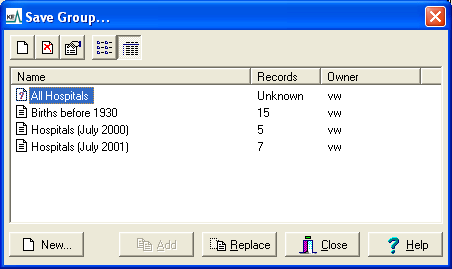After a search has been run you may want to save the group of records returned so that you can access them again; or you may want to save the search criteria used to generate this group of records (especially if the search is quite involved). There are thus two types of group:
|
Type of Group |
Description |
|---|---|
|
Static |
This is a set of records generated by a search. The Internal Record Numbers (IRN It is possible to add records to this type of group. In the various Group boxes (Restore Group, Save Group) accessed from the Tools>Group menu, a static group can be identified by the
|
|
Dynamic |
Rather than a set of records, a dynamic group is the search criteria used to generate a set of records. This includes the actual search terms and any boolean operators or wildcards used to run the search. This allows you to run the same search again. Although the search criteria remain the same, the results set may differ each time the Group is retrieved as the data may have changed. In the various Group boxes (Restore Group, Save Group) accessed from the Tools>Group menu, a dynamic group can be identified by the
|
Groups can be created and managed using two methods:
- From within the source module for the records that make up the group, using the Tools>Group menu options.
- Using the Groups module
Note: Certain group management tasks, such as setting some Record Level Security permissions and managing Query type groups can only be undertaken using the Groups module.

